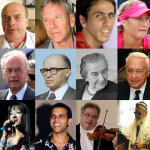Heads or tails? – Ki Tissa
 To assess the state of the Jewish people we need to count heads – how many have heads that think as Jews – and tails (how many take their seats in the assembly of world Jewry).
To assess the state of the Jewish people we need to count heads – how many have heads that think as Jews – and tails (how many take their seats in the assembly of world Jewry).
Both are important, but it may be that not enough attention is given to the heads and the thoughts. What is the level of Jewish cerebral activity? What do Jews think about?
In every age there were special individuals who were passionately concerned with the meaning of life, and the meaning of Jewish life.
The Greek thinkers had a principle, “Know thyself”. In Judaism it has two facets – “Know thyself as a person”, and “Know thyself as a Jew”.
But the two are interwoven – I am a person and a Jew at one and the same time, and neither can be considered on its own.
I know that there was a stage when Jews were told, “Be a Jew in your house and a man in the street”. The advice is understandable in the light of the Jewish attempt to integrate into European society, but it does not take account of the nature of Jewishness, which requires us to be man and Jew/Jew and man at one and the same time.
My Jewishness determines what sort of person I am and how I impact on society; my humanness determines what sort of Jew I am and how I impact on Jewish life.
The Midrashic sages said that the Torah was given to flesh and blood, not to angels: my Jewish commitment is not beyond my earthly capacity.
Abraham Joshua Heschel said, “Jewish piety may be expressed in the form of a supreme imperative: Treat thyself as an image of God. It is in the light of this imperative that we can understand the meaning of the astonishing commandment: ‘Ye shall be holy, for I the Lord your God am holy’.
“Holiness, an essential attribute of God, may become a quality of man. The human can become holy.”



